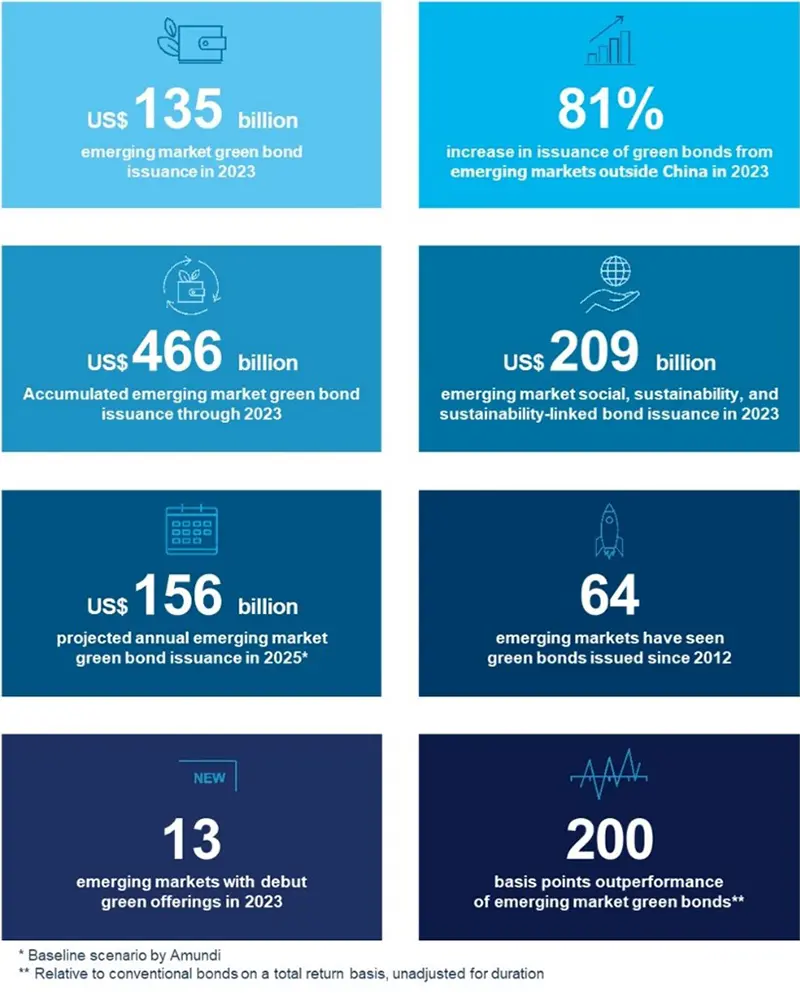Summary
Executive summary
Sustainable finance, the capital market used by borrowers to fund projects and initiatives with sound environmental and social credentials, is booming in developing economies.
Emerging market issuance of green, social, sustainability, and sustainability-linked (GSSS) bonds, which are eligible investments for funds focused on environmental and social criteria, surged 45 percent in 2023 to reach $209 billion, an all-time high.
For emerging markets outside China, growth was even faster, at 65 percent, reaching $111 billion over the year. In China itself, meanwhile, GSSS bond issuance advanced by 28 percent to around $98 billion.
This marks an impressive bounce back from the slump in sales seen the previous year when inflation stifled demand among investors who were worried about the declining value of their bond holdings, while rising interest rates prompted borrowers to put their capital raising plans on hold.
The recent growth in emerging market GSSS bond issuance is also set to continue, according to the central forecasts outlined in this report, rising by around 7.1 percent each year through 2025. That means sales volumes will reach around $240 billion in 2025.
There are multiple forces driving this upsurge that are likely to stay in place over the next two years. Easing inflationary worries, projected rate cuts by the U.S. Federal Reserve and other central banks, and benign growth outlooks in many emerging markets are behind much of the trend.
But growth in GSSS bond sales can also be largely attributed to governments and companies stepping up efforts to confront the climate challenges they face, transforming economies and businesses to make them more sustainable while building resilience. All this needs to be funded and the international financial markets connect these borrowers with a growing pool of portfolio capital that prioritizes environmental, social, and governance criteria when choosing assets to buy.
In short, rising financing needs to fund green transitions in emerging markets are meeting growing demand that is capable of absorbing more growth in GSSS bond issuance.
At the same time, financial and regulatory conditions are favoring emerging market issuers. Market growth is being supported by ongoing progress by market supervisors in establishing guidelines for categorizing, regulating, and tracking sustainable finance in multiple jurisdictions. This means sustainable finance markets in developing economies are becoming deeper, easing the way for more investment capital to buy up debt issued in those markets.
This study also shows that the new investment is finding its way to where it is most needed, not just alleviating the perennial problem of capital scarcity in emerging markets but targeting crucial economic sectors. Data on how the proceeds of green bond sales are used show a rapidly rising share going toward greener construction, a central pillar of many emerging economies as well as a major source of greenhouse gas emissions.
The largest slice of the money raised from the instruments in emerging markets during 2023 was designated for renewables, though at 37 percent the share was broadly stable relative to the previous year. The next biggest destination for money raised from sales of green bonds, and rapidly closing the gap, was buildings, claiming 29 percent of the total from 9 percent a year earlier. Water projects have also become increasingly important, representing 12 percent of issuance in 2023, up from 8 percent. This is due to a rise in sales of blue bonds, a sub-category of green bonds used to raise money for water and ocean-related sustainability. Low carbon transport saw its contribution fall to 11 percent from 18 percent in 2022.
Among the most significant innovations over the year within the GSSS bond market, we also highlight the inclusion of a social key performance indicator in Chile's Sustainability-Linked Bond Framework that was updated in June. This introduced a gender-based metric targeting an increase in female representation on the boards of companies regulated by the Financial Market Commission to at least 40 percent by 2031.
To be sure, a step up in GSSS bond sales could lead to more debt on balance sheets and issuers’ capacity for borrowing has limits. Nevertheless, there is room for issuance to grow from current levels and GSSS bonds still represent a fraction—around 5 percent—of annual emerging market bond issuance outside China where the proportion is smaller still, at 1.7 percent.
This report starts by outlining the financial market trends that underpin the new issuance market for GSSS bonds in emerging markets. A second chapter breaks down primary market performance during 2023 from several perspectives, looking at issuance by region, trends in the use of proceeds and other features. The third chapter sets out the forecasts compiled by Amundi for issuance volumes over the next two calendar years, and a concluding section sketches some potential considerations for policy makers, regulators, investors, issuers, and multilateral development banks seeking to ensure the continued health of this market.
Private investment is vital for covering the financing needs of governments and corporations seeking to meet net-zero and other climate commitments made at international summits such as COP28, as well as building resilience to ever more frequent extreme weather events. The GSSS bond market is a key medium for channeling private funds toward the emerging markets where it is needed the most.
Main 2023 Highlights

Labeled Bonds: Definitions and Guidelines
Green bonds: Fixed-income instruments with proceeds earmarked exclusively for projects with a positive environmental impact. The Green Bond Principles, guidelines developed by the International Capital Market Association (ICMA), have four components: use of proceeds, process for project evaluation and selection, management of proceeds, and reporting. These principles were last updated in June 2022. Several countries and jurisdictions have developed guidelines for green bond
issuance, many of which align with the Green Bond Principles. A related category, blue bonds, focuses on financing water-related sustainable projects.
Social bonds: Proceeds from social bonds are directed toward projects that aim to achieve positive social outcomes, especially, but not exclusively, for a target population. ICMA's Social Bond Principles have four components analogous to the Green Bond Principles: use of proceeds, the process for project evaluation and selection, management of proceeds, and reporting. The 2017 Social Bond Principles were updated in June 2020 to reflect changes in the market in light of COVID-19, notably by expanding social project categories and target populations.
Sustainability bonds: Sustainability bonds are debt instruments that raise money to finance or refinance a combination of green and social projects. The Sustainability Bond Guidelines established by ICMA are aligned with the core components of both Green and Social Bond Principles.
Sustainability-linked bonds: These instruments are performance-based bonds whereby their financial or structural characteristics, such as the coupon rate, are adjusted depending on whether the issuer achieves predefined sustainability objectives. The objectives are measured through key performance indicators and assessed against sustainability performance targets. Failure by the issuer to meet those goals may result in a higher coupon. These bonds can also be structured to reward better-than-expected performance with a lower coupon. Unlike social or green bonds, proceeds are not earmarked for specific projects. In June 2020, ICMA published the Sustainability-Linked Bond Principles, providing guidelines on structuring features, disclosure, and reporting.
Climate transition bonds: This category of debt aims to finance the transition to a low-carbon economy. The "Climate Transition Finance Handbook" published by ICMA in December 2020 recommends disclosures for issuers marking either use-of-proceeds or sustainability-linked instruments with a climate transition label. There are four key elements to the recommended disclosures: the issuer's climate transition strategy and governance, the environmental materiality of its business model, the climate transition strategy that must be science-based and include targets, and the transparency of
implementation.
Other labels: Some issuers have used other marketing labels for sustainable debt funding, such as adaptation, or SDG (Sustainable Development Goals) bonds. Most of these are use-of-proceeds bonds aligned with ICMA principles, but their branding has been adapted to single out a specific feature. Some bonds labeled "sustainable development bonds" depart from ICMA principles, as they are not "use-of-proceeds" bonds but are general purpose securities from issuers who wish to flag that their mission is inherently sustainable. The proliferation of labels requires vigilance from investors around project eligibility, allocation, and impact reporting commitments.





